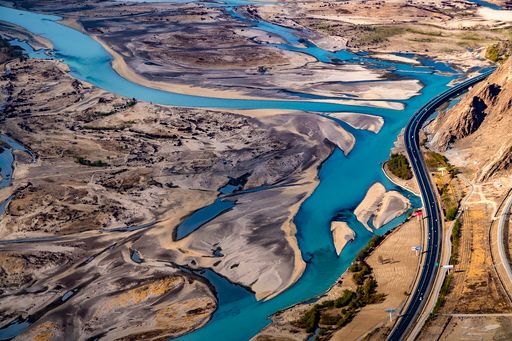On July 21, when Chinese Premier Li Qiang announced the start of construction of the Motuo hydroelectric dam on the Yarlung Tsangpo, a wave of anger and concern swept over India.
The fear that the two countries which share transboundary rivers might one day go to war flared again. When the upstream country of the upper tributaries builds a dam, those downstream from the riparian states often fret.
“What if it turns off the tap?” is the recurring fear. Arunachal Pradesh’s Chief Minister, Pema Khandu, called the project “a waterbomb”.
Indian TV channels painted scenarios of catastrophe. Western news outlets chimed in and framed the issue in terms of a Sino-Indian power contest.
The Yarlung rises from glaciers on the Tibetan plateau, loops into India’s Arunachal Pradesh (where it becomes the Lohit), flows through Assam as the Brahmaputra, and enters Bangladesh as the Jamuna.
This river is not just a waterway but a cultural artery.
Millions of farmers and fishermen depend on it; Hindus bathe in it for spiritual cleansing; poets have sung its praises and written odes to it. In the early 20th century, British spies even traced it upriver to confirm its connection to the Brahmaputra.
The two nuclear-armed neighbours clashed over a disputed border in 2020, challenged each other diplomatically and are in a race to dominate Asian affairs. China even claims Arunachal Pradesh in full, calling it “South Tibet”.
But Aaron Wolf, a professor of geography at Oregon State University and a leading authority on transboundary water agreements, is unbothered.
“We find tensions on international rivers pretty regularly. I think the sequence is first political people and oftentimes the press are focused on the conflict side and conflict potential,” he tells TRT World.
Wolf is the author of a seminal 1999 paper that argues countries more often reach a settlement than rush into a conflict over shared rivers.
“Generally, what happens is that the sides often reach some kind of agreement, and sometimes those agreements last for decades and sometimes even while there are disputes over other issues.”
But how did the notion of the next big war being fought on water stick?

Notional ‘water wars’
In 1995, Ismail Serageldin, the former vice president of the World Bank, famously said: “If the wars of this century were fought over oil, the wars of the next century will be fought over water - unless we change our approach to managing this precious and vital resource.”
Serageldin, an Egyptian, was anxious about Ethiopia’s plans for a Nile dam. The Grand Ethiopian Renaissance Dam was built amid diplomatic haggling with Egypt and Sudan, but no war.
Serageldin wasn’t alone in making the grim assessment. In 2001, Kofi Annan, the then UN Secretary-General, also feared that a tussle over fresh water could easily lead to war.
But Wolf and other experts, who have meticulously studied water conflicts, say not a single war has ever been fought exclusively over water, with the exception of perhaps the war between Umma and Lagash, two city-states in ancient Iraq, some 4,500 years ago.
“I’m not saying there’s not going to be a water war one day. Maybe there will be. But what I will say is we have a record of 800 water treaties between people who don’t like each other, and we have very little record of actual violence across borders, specifically over water,” says Wolf.
The “water war” narrative emerged around the time the Cold War was coming to an end, and there was hope that all the money that had gone into military expenditure would now be spent on schools, hospitals and libraries, he says.

Water wars and semantics
The Indus Waters Treaty (IWT), signed in 1960, has survived three wars between India and Pakistan.
Even after a four-day flare-up in May 2025, when rockets and missiles were exchanged, New Delhi took aim at the treaty. Islamabad immediately threatened that any attempt to divert water would be considered an act of war.
Here again, Wolf doesn’t see any reason to jump on the war-mongers’ bandwagon.
“I always divide what I hear from politicians and what I hear from water people. Politicians are generally speaking to their constituents,” he says.
India didn’t cancel the IWT or walked away from it. New Delhi instead said it was holding the treaty in ‘abeyance’. “That’s a very specific phrase. So far, we have not seen any hydrological repercussions from the statements,” says Wolf.
China has no formal water-sharing agreement with India. It is reluctant to sign binding multilateral treaties on transboundary rivers.
That doesn’t mean China shuns cooperation with other countries on managing the flow of water, says Wolf.
“China’s not big on multilateral agreements on international basins”, but it still cooperates on “data sharing, early warning and agree on water quality. Sometimes, the agreement is implicit and not explicit.”
The Motuo project, costing an estimated $167bn and capable of generating enough electricity to power England for a year, sits in a seismically active zone.
That means sharing reliable and timely data would be important for India and Bangladesh to avoid any sudden surge in flow.
Melting snow on the glaciers, erratic Monsoon pattern and floods, which have hit India and China in recent years would further incentivise cooperation, says Wolf.
“There’s no doubt about all these pressures. But my sense based on history is that we are not going to rush towards war. War doesn’t solve anything. You don’t get any more water if you go to war,” he says.



















